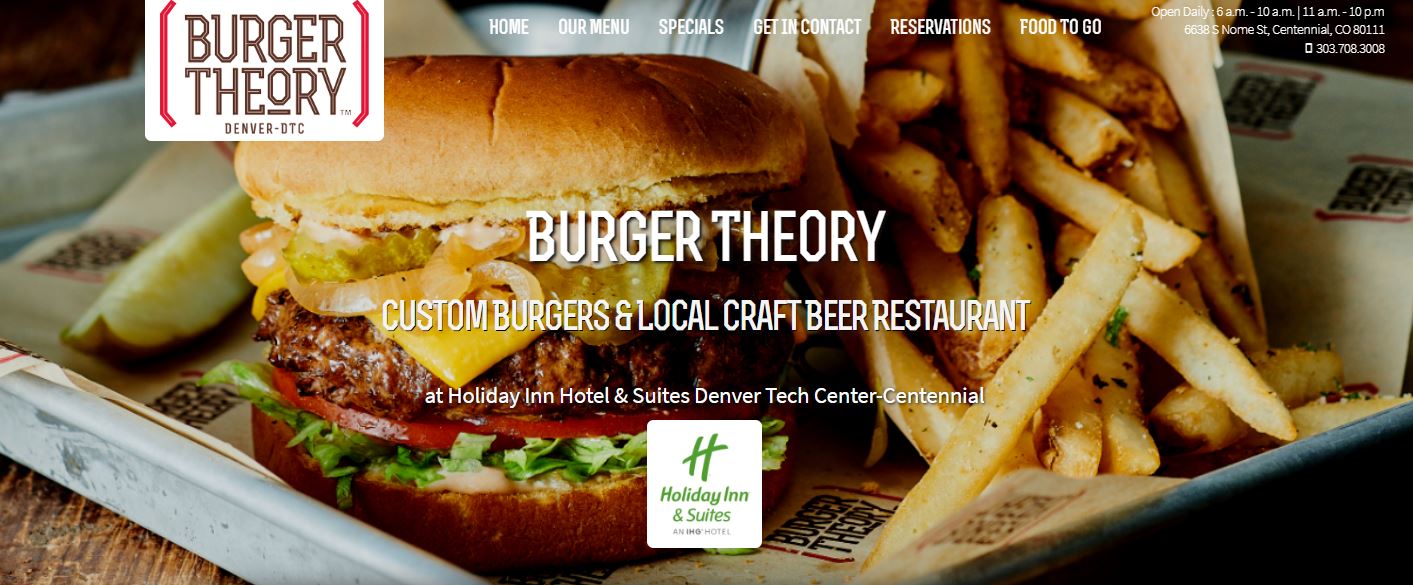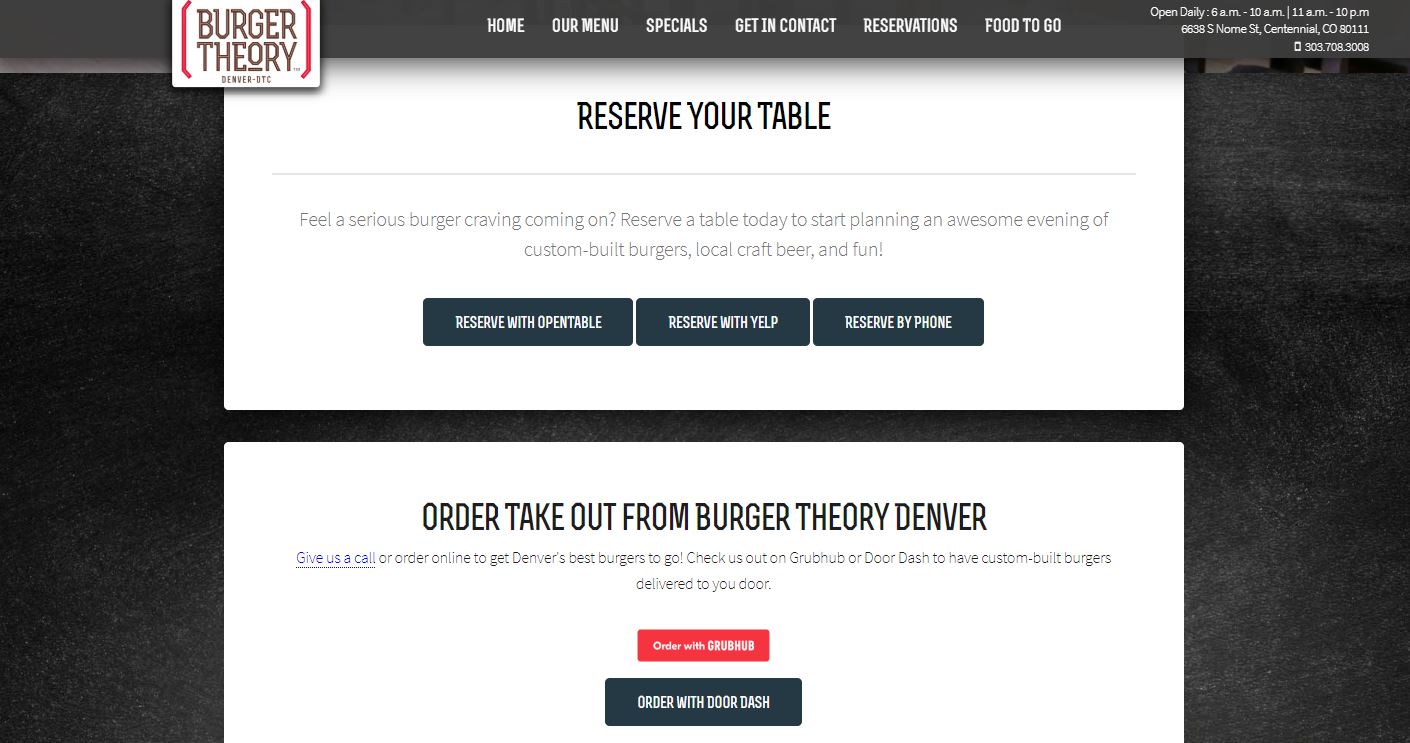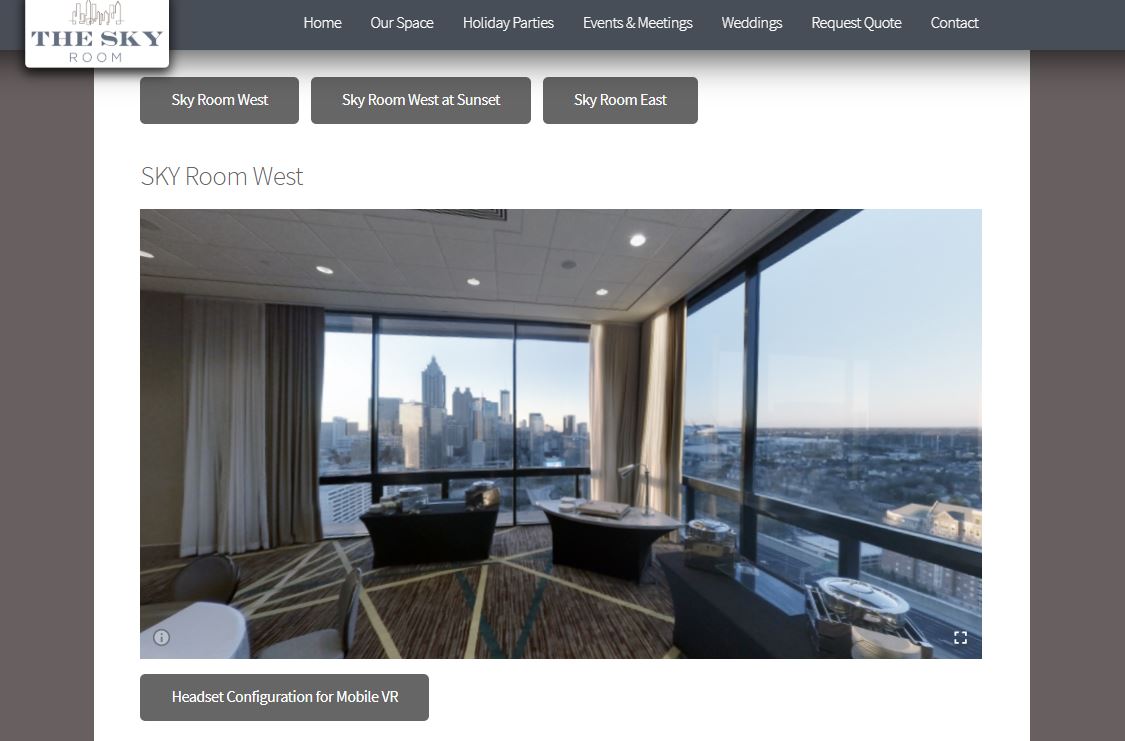Some hotels are cookie-cutter. Most are not. Think about your hotel right now. It has a unique space – perhaps the restaurant with the best burgers the town has ever tasted, or the event venue features jaw-dropping skyline views unlike anything else in the city. It is a standalone spot that would draw in customers even if the hotel never existed… but no one knows about it. You want people to know about it.
How do you make people notice these incredible places on a hotel website designed for booking hotel rooms? Solution: Give the space its own unique branding and a microsite of its very own.
We will look at three different types of social spaces that have increased their revenue as a direct result of having their own branding and microsite.
- Entertainment Venues
- Restaurants & Bars
- Social Event Venues
Microsites for Entertainment Venues
Some hotels have music halls and performance art venues onsite. Take Cambria Nashville for example. They have a stellar hotel website designed to showcase the hotel and drive hotel room bookings. While the site does have a landing page about the True Music Room, the hotel is the main focus of the site. The hotel is the headliner and the True Music room is just an opening act.

But the True Music Room is its own special attraction unrelated to the hotel and it deserves its own microsite to target its separate audience and strut what it is all about.
So they worked with Blue Magnet to build the True Music Room Microsite, an entire site dedicated to the bar and entertainment venue. Look at the difference in the screenshot below. The True Music Room has “the stage” to itself. At first glance at the site, you may not even realize the venue is on the roof of the hotel – and for marketing, that can be a good thing.

From the Audience’s Perspective
Let’s think about music venues from the audience perspective first. When it comes to music and performance art venues, the general public wants places that are “trendy,” “unique,” and “boutique.” By giving your entertainment venue its own microsite, you are giving it its own unique identity.
Put yourself in the shoes of someone seeking a music venue. You are the audience right now. What do you want to see when you go to a site about the True Music Room? You want to know:
- What musical artists are performing & when
- How to purchase tickets for shows
- What the food and drink menus look like
- What the venue looks like
- Where the venue is located
- If there is parking onsite
- What the capacity is for this spot
- If the venue available for rent
- What the costs are to rent the space
- How to sign up to perform here
- Who has performed here in the past
- How to contact the venue for any other questions
That is a lot of information to include on a single landing page on a hotel website. If all that information is on a single page, you would have a difficult time scrolling to find the info you need, especially on a small mobile screen.
Take this calendar for example. This would be extremely difficult to include on a landing page with slews of other information.

However, the event calendar has its own page on the microsite that is easy to navigate to and interact with, granting you and any other music lover a better user experience.
From the Sales and Marketing Perspective
Now, put your sales and marketing shoes on. Your goal is to drive as much business to this music venue as possible, and the people you want to connect with are not necessarily hotel guests. They are music lovers of all sorts: hotel guests, vacationers staying at other hotels, and also locals. They all want different things. Some may want a bar with music, some may want tickets for a particular show, some may want to book a show at your venue, and some may want to buyout the space for an event.
When you only have a single landing page on a hotel website, it is difficult to provide the information each segment of your site visitors want based on their different objectives. With a microsite you have the space to create these neat and tidy conversion funnels and, ultimately, yield better results.

Results & Conclusion
Giving your music venue its own microsite will give it its own identity separate from the hotel and ultimately bring in more revenue. Learn other clever techniques the True Music Room and similar businesses use to increase their revenue.
Microsites for Restaurants
So maybe your hotel does not have its own music venue on the roof, but I bet it has a restaurant. Whether this restaurant is casual or luxury, giving the restaurant its own branding and microsite for customers to explore leads to more conversions and revenue.
For this example, we are going to look at Burger Theory, a restaurant at the Holiday Inn & Suites Denver Tech Center – Centennial. The brand site dining page provides an incredibly limited space to display photos, menus, and specials for the restaurant.

However, the hotel worked with Blue Magnet and created a microsite to showcase the restaurant more effectively.

What a difference! It does not take a skilled marketer to tell you which version is better at first glance. But for the sake of analysis, we will explore why the microsite is so much more advantageous for the restaurant than the regular dining page on the brand hotel website.
Scott Turbow, the hotel’s general manager shared his perspective on the site, “I find a microsite to be an integral part of our business. We have seen visits grow every month, the site is robust and easy to navigate and overall it makes for another, necessary, sales tool to grow our business and our presence in both our community and on the web.”
From the Audience’s Perspective
Okay, you are the audience again. What do you want in a restaurant website?
- Photos of what the space looks like
- Menus of the food and drinks
- Hours of operation
- Easy guidance to make reservations
- Special offers and happy hour info
- Idea of the space’s atmosphere
- Directions to the space
While the brand site tries to provide all that information, it cannot include everything due to the limitations of the brand template it must abide by. Especially atmosphere. The brand site does not have the text space or font freedom to clue visitors in on what this space is about, but the microsite does. Look at some of this content on the microsite:

This text sets the scene for what you are going to experience when you sit down at a table. It is a casual burger bar for foodies and craft beer-lovers. It is clean, sophisticated, artsy, and down-to-earth. These are all words that appeal to a certain audience when choosing a restaurant. And when people choose a restaurant, they are not just choosing the food they will eat, but also what their social experience will be. They will buy with the feelings that resonate with them. With a microsite, you have the room and flexibility to create these emotions within a site visitor and ultimately convince them to enjoy the restaurant.
Finally, one of the most advantageous things a restaurant can do with a microsite is dedicating a whole page to their menu. You have probably visited hundreds of restaurant websites in the past ten years. How frustrating is it to read menus as a PDF on your phone? It is incredibly tedious! Yet, so many restaurants continue to feature their menu on their site as a PDF. Why? Because it is faster and easier for restaurants to upload the PDF they have already created than take the time to type all the items again onto a webpage.
However, you have a much better user experience when you can read the menu items easily on your screen without having to zoom in and out of the PDF to read everything. If you have a dietary restriction – let’s say allergies to gluten – you need to scroll through the options easily to find gluten-free options to determine if you can go to the restaurant in the first place. If you have a good user experience on the website, you are more likely to walk through the door and order a burger.
From the Marketer’s Perspective
Put on those marketer’s shoes again. We just explored how laying out a menu as text on a page rather than a PDF is better for user experience. Did you know the technique is also better for SEO as well?
When you lay a menu out in HTML with proper tags, you can optimize the menu page for very specific items. For example, someone in Denver is craving a Chicago-style hot dog. They do a quick search in the area for restaurants that serve them and because Burger Theory lays out its menu items as HTML text, search engines find the result and serve it to the person asking the question because this is on the site:

Other restaurants in Denver might serve Chicago-style hotdogs too, but because their menus are in PDFs, search engine bots cannot crawl and read an image well enough. Taking the time to lay out the menu in HTML text is a concrete way to get an edge over your competitors.
Featuring an HTML formatted menu on its own page a big win for marketers, but that is not the only reason why having a microsite helps bring in more revenue. Similar to a music venue, restaurants have different conversion funnels than a hotel does. A restaurant microsite allows you to lead customers to make the conversion action you both desire. For example, on the brand site, you cannot link to a reservation system and you can not link to order food to go via Grubhub or DoorDash. The microsite can and does, allowing you to create conversion funnels for people who want to reserve a table, order to go, or just see the menu and stop in.

Special offers are a great way to push people who are on the fence about going to your restaurant to make the jump and come on in. With a microsite, the restaurant has more freedom to change up specials and showcase it in a fun way.
For example, Burger Theory has a whole specials page featuring their $10 lunch combos. Site visitors not only can see that they have a $10 lunch special, but they also can see which menu items are included in that special.

When the restaurant faces a need period and wants to run a social media ad campaign about their $10 lunch combos, they can link people from social media to this specific page so people find what they are looking for faster. With that smooth campaign in place, the restaurant will capture more business in that time of need.
Conclusion
Blue Magnet witnesses hotel restaurants flourish time and time again when they invest in a microsite. As another example, check out Emily Morgan Hotel’s award-winning restaurant, Oro Restaurant. Kole Siefken, General Manager of The Emily Morgan Hotel and Oro Restaurant shared, “There are many items I like about the site, but the most impressive is the overall design and vivid photography makes it look as if it is an independent restaurant within our hotel. I like that it showcases Oro as it’s own Brand and since it is updated easily and often. It really has had success in additional sales.”
If you are committed to giving your restaurant a digital makeover, learn how digital marketing supports your restaurant rebranding efforts.
Microsites for Event Venues
The last hotel features we are taking a closer look at are event spaces. Your hotel might have a truly special event venue for weddings and other social parties, but you have trouble showcasing just how unique it is on your hotel website. How do you make your hotel event space stand above all the chic boutique venues in the area? The answer of course is to give the space its own unique identity, separate from the hotel brand name, and create a microsite to showcase everything the space offers.
A perfect example is the Crowne Plaza Atlanta Midtown’s 25th floor event space called The SKY Room. The Crowne Plaza wanted to sell how unique this one was with its floor to ceiling windows revealing downtown Atlanta’s skyline. So they worked gave this particular room its own logo, branding, and microsite separate from their already existing hotel independent site.

From the Audience’s Perspective
Put on those audience glasses one last time. For any social event venue, but particularly wedding event venues, if you had a choice between hosting an event at a Crowne Plaza or at The SKY Room, which would you pick? The SKY Room. It is the same exact venue, but the “SKY Room” sounds much more modern, boutique, and interesting. Separating the two can help a hotel event space compete with all the popular boutique event spaces everyone wants to stay at.
When you go to a website to learn about a potential space for your event, you are looking to virtually walk the floor of the venue – get a feel for the atmosphere this space will add to your event. It is very difficult to get an idea of that atmosphere on a site designed for hotel bookings. On a site designed to showcase the event space, you can see more photos, look at 360 or VR views, and read verbiage specifically about the space. The more you feel you are actually there, the more you will fall in love with it and be likely to book. For example, Blue Magnet found that when people look at VR of your event space, it increases the likelihood of them submitting an RFP or calling the event team immediately following.

Additionally, you can find the details you are looking for when they come to a site specifically dedicated to the event space, such as:
- Floor Plans
- Vendor Lists
- Packages
- Catering Menus
- Chef and Event Planner Information
- Photos, VR, & 360 tours
- Contact Information
This is a lot of information for a single page on a hotel website. While you can scrunch these details on a single page, the microsite will foster a more positive user experience when that information is spread out and easy to navigate through. And when potential customers have a good user experience, they are more likely to take an action – like submitting an RFP for a venue.
From the Marketer’s Perspective
Lace up those marketer’s shoes one last time. The audience you target for an event space is vastly different from those you target for transient hotel rooms. With a microsite you can create more effective funnels for people seeking to book specific events.
The SKY Room has three unique funnels: Weddings, Events & Meetings, and Holiday Parties. Each page has its own keyword strategy to capture people looking for very specific event spaces. For example, someone planning a wedding will type in queries like, “wedding venues in atlanta” versus a person looking to put together a holiday party who searches for, “corporate holiday parties in atlanta.” Separate pages allows your hotel to strategically target both searchers despite their different goals.

Multiple pages do not just benefit organic traffic, they also benefit your paid efforts too. A PPC or paid social media campaign will perform better when users are directed to unique pages related to the campaign.
Conclusion
In the first three months of the SKY Room launching their microsite and targeted PPC campaign, the venue gained 11 event bookings resulting in $90,000-$100,000 in revenue!
Want to learn more about how SKY Room microsite gained six figures in three months? Read the full details in the SKY Room Case Study .
Where to Go From Here
If your hotel has a special space with the potential for more business, it may very well need its own microsite. Whether that space is a music venue, restaurant, event venue, or something else entirely, contact the marketing experts at Blue Magnet who will be happy to provide you with more information, case studies, and ideas to help the venue bring in the revenue you know it can.




